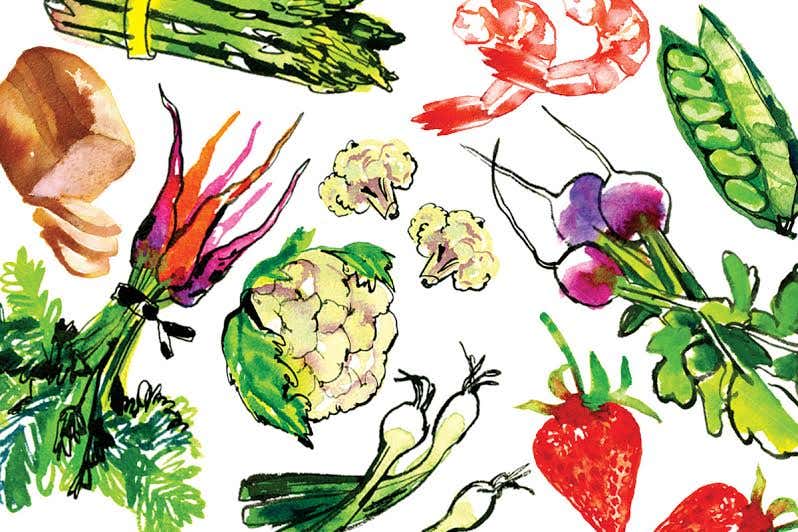
Treasure in the Woods
The chanterelle, prized for its bold golden color and sweet, earthy flavor, is one of the world’s most esteemed mushrooms.
We set off across our neighbor's muddy field towards the woods, baskets in one hand, umbrellas in the other, with our retriever, Coffee Bean, bounding after us. We have come, as we do every summer, in search of the chanterelle—one of the hardiest of the wild mushrooms, known for its glorious golden color and preposterous fleshy shapes. It is only the first week of July (we usually don't gather until midmonth), but the spring's heavy rains have encouraged us. There's an old saying: When the weather is thunderous, chanterelles are numerous.
The most common of the edible chanterelles is Cantharellus cibarius, abundant in the northeastern United States from July to August. This variety can also be found in the Northwest and on the West Coast—as well as in Europe, where dogs are sometimes trained to sniff out their apricot-like scent. (But not here, in New York's Finger Lakes region; and not Coffee Bean, who scoots into the hedgerow, hunting rabbits.)
When my wife, Susan, and I first bought our summerhouse in tiny Mecklenburg, New York, nine miles from Cayuga Lake, our neighbor gave us permission to hike in the field next door and in the woods behind it. It was on an overcast day like today, years ago, that we came across the first chanterelles we'd ever seen. Their bold color stopped us in our tracks. We consulted our field guide to confirm their identity, then brought them home and sauteed them in butter, folding the fragrant mixture into eggs for what turned out to be the best omelette we'd ever had. One taste of our chanterelles—at once delicate and wild—and we were hooked.
Now we are beginning our 14th summer of foraging in these woods. As we enter the forest, the daylight instantly goes murky. From the thick canopy comes a thrumming drip, loud and insistent. The puddled path winds up a hill towards a stone mound that must have been a house or barn foundation when these woods were cleared sometime in the last century. Chanterelles are gregarious, growing in groups and returning to a favorable environment in precisely the same spot. In summers past we'd found them here in great number. As we near the mound, Susan suddenly stops. ''There'', she says. And there they are, pushing through dead leaves and patches of bright green moss: circles and whorls of gold—chanterelle crowns just pushing up, the wild and auric treasure for which we've come.
To the Germans, it is the eierschwamm (egg mushroom) or gelbhahnel (yellow chick); to the Italians, it's the capo gallo (cock crest) or orecina (little ear). The French identify it as the girolle, from the Old French word girer _(''to twist''), a reference to its coiled shape, or as the chanterelle, from the Greek _kantharos, meaning ''a drinking vessel''. By whatever name, _Cantharellus cibarius _and other species have been abundant throughout Europe for centuries; the first illustration of one appeared in Holland in 1581.
Like other forest mushrooms, chanterelles grow only in the presence of living trees, with which they form a symbiotic relationship. The fungi draw sugar and carbohydrates from the trees' younger roots, in turn providing them with phosphorous and other minerals. Thus, despite the best efforts of mycological entrepreneurs, chanterelles are still hand-gathered in the woods—which is why they're so expensive (up to $35 a pound in some stores). But because their color and form are so distinctive and because they grow in such profusion when conditions are right, chanterelles are among the safest and easiest mushrooms to gather. (Toxic look-alikes—the jack-o'-lantern, named for its glow-in-the-dark orange coloring, and several false chanterelles—do exist, and any fungus's identity should be verified with an experienced forager.)
In 1836 a Swede named Elias Fries, one of the founders of modern mycology, wrote of the chanterelle, ''It is considered everywhere one of the most important and best edible mushrooms.'' His enthusiasm notwithstanding, the fact is that chanterelles were not eaten much in Europe until the late 19th century—and then primarily by the French upper classes. There are several uniquely North American chanterelle varieties—among them _Cantharellus formosus _(which is large and deep orange) and _Cantharellus subalbidus _(stubbier and nearly white)—but the cibarius, which grows on both sides of the Atlantic, has been prized here since at least the late 19th century. In his 1894 annual report, Charles H. Peck, state botanist of New York, wrote, ''[The chanterelle] grows in groups but sometimes in curved lines, as if trying to form a 'fairy ring'.... My own trials of it would lead me to place it among the best and most important of our wild mushrooms.''
In honor of the season, we've planned a chanterelle feast tonight at the home of our good friends Annie and Harley Campbell. Annie, an artist, and Harley, a songwriter, have invited several other avid foragers—among them Victoria Romanoff, who recently sold her Ithaca restaurant, Trattoria Tre Stelle, which specialized in wild mushrooms. Susan and I prepare roasted cod with sauteed chanterelles, and Romanoff has brought chanterelle butter, as well as a basketful of Craterellus cornucopioides, a thin-fleshed, gray-black member of the chanterelloid (or chanterelle-like) fungi, known as the horn of plenty—and sometimes more ominously as the trumpet of death. When Romanoff sautes these mushrooms, they release a dark fluid reminiscent of squid ink, with a trufflelike aroma.
As we sit in Annie's dining room, surrounded by dozens of burning candles, the table groaning under the weight of our wild harvest, we worship, devotees all, at the altar of the chanterelle.
Keep Reading
Continue to Next Story










